南极洲介绍英语.
南极洲作文英文
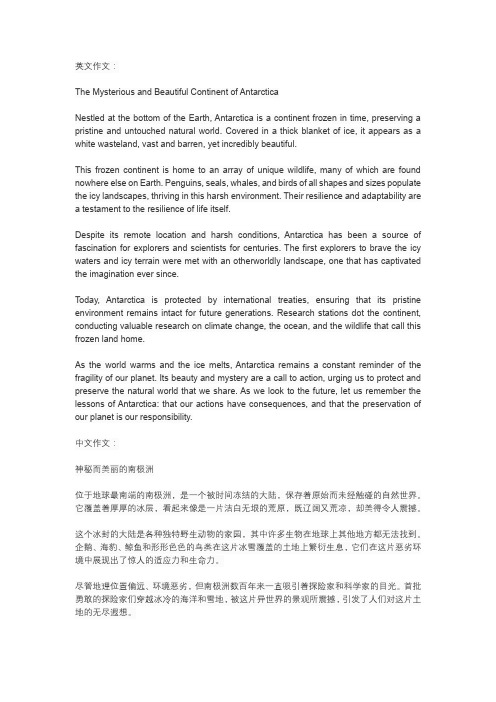
英文作文:The Mysterious and Beautiful Continent of AntarcticaNestled at the bottom of the Earth, Antarctica is a continent frozen in time, preserving a pristine and untouched natural world. Covered in a thick blanket of ice, it appears as a white wasteland, vast and barren, yet incredibly beautiful.This frozen continent is home to an array of unique wildlife, many of which are found nowhere else on Earth. Penguins, seals, whales, and birds of all shapes and sizes populate the icy landscapes, thriving in this harsh environment. Their resilience and adaptability are a testament to the resilience of life itself.Despite its remote location and harsh conditions, Antarctica has been a source of fascination for explorers and scientists for centuries. The first explorers to brave the icy waters and icy terrain were met with an otherworldly landscape, one that has captivated the imagination ever since.Today, Antarctica is protected by international treaties, ensuring that its pristine environment remains intact for future generations. Research stations dot the continent, conducting valuable research on climate change, the ocean, and the wildlife that call this frozen land home.As the world warms and the ice melts, Antarctica remains a constant reminder of the fragility of our planet. Its beauty and mystery are a call to action, urging us to protect and preserve the natural world that we share. As we look to the future, let us remember the lessons of Antarctica: that our actions have consequences, and that the preservation of our planet is our responsibility.中文作文:神秘而美丽的南极洲位于地球最南端的南极洲,是一个被时间冻结的大陆,保存着原始而未经触碰的自然世界。
Antarctica 南极英文介绍
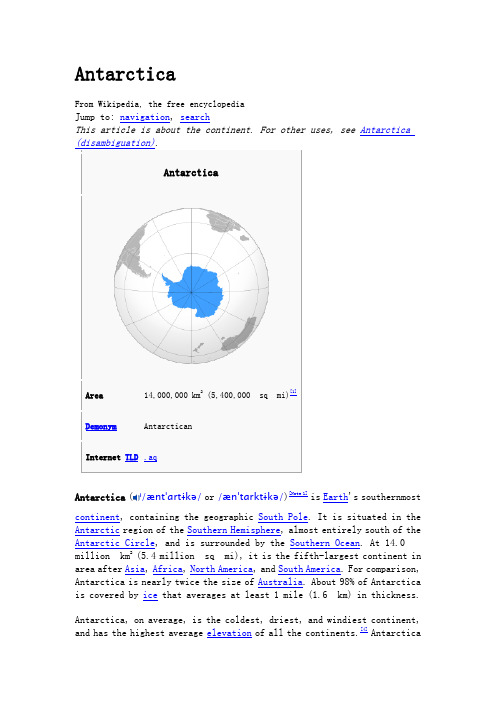
AntarcticaFrom Wikipedia, the free encyclopediaJump to: navigation, searchThis article is about the continent. For other uses, see AntarcticaAntarctica(i/æntˈɑr tɨkə/or /ænˈtɑr ktɨkə/)[Note 1]is Earth's southernmostcontinent, containing the geographic South Pole. It is situated in the Antarctic region of the Southern Hemisphere, almost entirely south of the Antarctic Circle, and is surrounded by the Southern Ocean. At 14.0 million km2(5.4 million sq mi), it is the fifth-largest continent in area after Asia, Africa, North America, and South America. For comparison, Antarctica is nearly twice the size of Australia. About 98% of Antarctica is covered by ice that averages at least 1 mile (1.6 km) in thickness.Antarctica, on average, is the coldest, driest, and windiest continent, and has the highest average elevation of all the continents.[4]Antarcticais considered a desert, with annual precipitation of only 200 mm (8 inches) along the coast and far less inland.[5] The temperature in Antarctica has reached −89 °C (−129 °F). There are no permanent human residents, but anywhere from 1,000 to 5,000 people reside throughout the year at the research stations scattered across the continent. Only cold-adapted organisms survive there, including many types of algae, animals (for example mites, nematodes, penguins, seals and tardigrades), bacteria, fungi, plants, and protista. Vegetation where it occurs is tundra.Although myths and speculation about a Terra Australis("Southern Land") date back to antiquity, the first confirmed sighting of the continent is commonly accepted to have occurred in 1820 by the Russian expedition of Fabian Gottlieb von Bellingshausen and Mikhail Lazarev on Vostok and Mirny. The continent, however, remained largely neglected for the rest of the 19th century because of its hostile environment, lack of resources, and isolation. The Antarctic Treaty was signed in 1959 by 12 countries; to date, 49 countries have signed the treaty. The treaty prohibits military activities and mineral mining, prohibits nuclear explosions and nuclear waste disposal, supports scientific research, and protects the continent's ecozone. Ongoing experiments are conducted by more than 4,000 scientists from many nations.Contents[hide]∙ 1 Etymology∙ 2 History of exploration∙ 3 Geography∙ 4 Geologyo 4.1 Geological history and paleontology▪ 4.1.1 Paleozoic era (540–250 Ma)▪ 4.1.2 Mesozoic era (250–65 Ma)▪ 4.1.3 Gondwanaland breakup (160–23 Ma)▪ 4.1.4 Neogene Period (23–0.05 mya)o 4.2 Geology of present-day Antarctica∙ 5 Climate∙ 6 Population∙7 Biodiversityo7.1 Animalso7.2 Fungio7.3 Plantso7.4 Other organismso7.5 Conservation∙8 Politicso8.1 Antarctic territories∙9 Economyo9.1 Fisherieso9.2 Tourismo9.3 Scientific stations∙10 Researcho10.1 Meteorites∙11 Ice mass and global sea level∙12 Effects of global warming∙13 Ozone depletion∙14 Notes∙15 References∙16 External linksEtymologyThe name Antarctica is the romanized version of the Greek compound word ἀνταρκτική (antarktiké), feminine of ἀνταρκτικός(antarktikos),[6] meaning "opposite to the Arctic", "opposite to the north".[7]Before getting its present geographical connotations, the term was used for other locations which could be defined as "opposite to the north". For example, the short-lived French colony established at Brazil in the 16th Century was called "France Antarctique".The first formal use of the name "Antarctica" as a continental name in the 1890s is attributed to the Scottish cartographer John George Bartholomew.[8]History of explorationMain article: History of AntarcticaSee also: List of Antarctic expeditionsAntarctica has no indigenous population and there is no evidence that it was seen by humans until the 19th century. However, belief in the existence of a Terra Australis– a vast continent in the far south of the globe to "balance" the northern lands of Europe, Asia and North Africa– had existed since the times of Ptolemy (1st century AD), who suggested theidea to preserve the symmetry of all known landmasses in the world. Even in the late 17th century, after explorers had found that South America and Australia were not part of the fabled "Antarctica", geographers believed that the continent was much larger than its actual size.A key part of the story of how Antarctica got its name is how it did not get named Terra Australis. Australia got named after this instead, and it was because of the mistake made by people who had decided that no significant land mass further south of Australia would be found. Explorer Matthew Flinders, in particular, has been credited with popularizing the transfer of the name Terra Australis to Australia. He justified the titling of his book A Voyage to Terra Australis (1814) by writing in the introduction:There is no probability, that any other detached body of land, of nearly equal extent, will ever be found in a more southern latitude; the name Terra Australis will, therefore, remain descriptive of the geographical importance of this country, and of its situation on the globe: it has antiquity to recommend it; and, having no reference to either of the two claiming nations, appears to be less objectionable than any other which could have been selected.[9](For more info about how Australia got named after Terra Australis instead of Antarctica, see Australia#Etymology.)European maps continued to show this hypothesized land until Captain James Cook's ships, HMS Resolution and Adventure, crossed the Antarctic Circle on 17 January 1773, in December 1773 and again in January 1774.[10] Cook came within about 75 miles (121 km) of the Antarctic coast before retreating in the face of field ice in January 1773.[11]The first confirmed sighting of Antarctica can be narrowed down to the crews of ships captained by three individuals. According to various organizations (the National Science Foundation,[12]NASA,[13]the University of California, San Diego,[14] and other sources),[15][16] ships captained by three men sighted Antarctica in 1820: Fabian Gottlieb von Bellingshausen (a Baltic German captain in the Imperial Russian Navy), Edward Bransfield (an Irish-born captain in the Royal Navy), and Nathaniel Palmer (an American sealer out of Stonington, Connecticut). Von Bellingshausen saw Antarctica on 27 January 1820, three days before Bransfield sighted land, and ten months before Palmer did so in November 1820. On that day the expedition led by Von Bellingshausen and Mikhail Lazarev on ships Vostok and Mirny reached a point within 32 km (20 mi) of the Antarctic mainland and saw ice fields there. The first documented landing on mainland Antarctica was by the American sealer John Davis in West Antarctica on 7 February 1821, although some historians dispute this claim[citation needed].On 22 January 1840, two days after the discovery of the coast west of the Balleny Islands, some members of the crew of the 1837-40 expedition of Jules Dumont d'Urville disembarked on the highest islet[17] of a group of rocky islands about 4 km from Cape Géodésie on the coast of Adélie Land where they took some mineral, algae and animal samples.[18]In December 1839, as part of the United States Exploring Expedition of 1838–42 conducted by the United States Navy (sometimes called the "Ex. Ex.", or "the Wilkes Expedition"), an expedition sailed from Sydney, Australia, into the Antarctic Ocean, as it was then known, and reported the discovery "of an Antarctic continent west of the Balleny Islands" on25 January 1840. That part of Antarctica was later named "Wilkes Land",a name it maintains to this day.Nimrod Expedition South Pole Party (left to right): Wild, Shackleton, Marshall and AdamsExplorer James Clark Ross passed through what is now known as the Ross Sea and discovered Ross Island(both of which were named for him) in 1841. He sailed along a huge wall of ice that was later named the Ross Ice Shelf. Mount Erebus and Mount Terror are named after two ships from his expedition: HMS Erebus and Terror.[19]Mercator Cooper landed in East Antarctica on 26 January 1853.[20]During the Nimrod Expedition led by Ernest Shackleton in 1907, parties led by Edgeworth David became the first to climb Mount Erebus and to reach the South Magnetic Pole. Douglas Mawson, who assumed the leadership of the Magnetic Pole party on their perilous return, went on to lead several expeditions until retiring in 1931.[21]In addition, Shackleton himself and three other members of his expedition made several firsts in December 1908 –February 1909: they were the first humans to traverse the Ross Ice Shelf, the first to traverse the Transantarctic Mountain Range (via the Beardmore Glacier), and the first to set foot on the South Polar Plateau. An expedition led by Norwegian polar explorer Roald Amundsen from the ship Fram became the first to reach the geographic South Pole on 14 December1911, using a route from the Bay of Whales and up the Axel Heiberg Glacier.[22]One month later, the doomed Scott Expedition reached the pole.Richard E. Byrd led several voyages to the Antarctic by plane in the 1930s and 1940s. He is credited with implementing mechanized land transport on the continent and conducting extensive geological and biological research.[23]However, it was not until 31 October 1956 that anyone set foot on the South Pole again; on that day a U.S. Navy group led by Rear Admiral George J. Dufek successfully landed an aircraft there.[24]The first person to sail single-handed to Antarctica was the New Zealander David Henry Lewis, in 1972, in a 10-meter steel sloop Ice Bird.GeographyMain article: Geography of AntarcticaSee also: Extreme points of Antarctica and List of Antarctic and subantarctic islandsLabelled map of Antarctica.Centered asymmetrically around the South Pole and largely south of the Antarctic Circle, Antarctica is the southernmost continent and is surrounded by the Southern Ocean; alternatively, it may be considered to be surrounded by the southern Pacific, Atlantic, and Indian Oceans, or by the southern waters of the World Ocean. It covers more than 14,000,000 km2(5,400,000 sq mi),[1]making it the fifth-largest continent, about 1.3 times as large as Europe. The coastline measures 17,968 km (11,165 mi)[1]and is mostly characterized by ice formations, as the following table shows:Coastal types around Antarctica[25]Type FrequencyIce shelf (floating ice front) 44%Ice walls (resting on ground) 38%Ice stream/outlet glacier (ice front or ice wall) 13%Rock 5%Total 100%Antarctica is divided in two by the Transantarctic Mountains close to the neck between the Ross Sea and the Weddell Sea. The portion west of the Weddell Sea and east of the Ross Sea is called West Antarctica and the remainder East Antarctica, because they roughly correspond to the Western and Eastern Hemispheres relative to the Greenwich meridian.Elevation colored by relief heightAbout 98% of Antarctica is covered by the Antarctic ice sheet, a sheet of ice averaging at least 1.6 km (1.0 mi) thick. The continent has about 90% of the world's ice (and thereby about 70% of the world's fresh water). If all of this ice were melted, sea levels would rise about 60 m (200 ft).[26] In most of the interior of the continent, precipitation is very low, down to 20 mm (0.8 in) per year; in a few "blue ice" areas precipitation is lower than mass loss by sublimation and so the local mass balance is negative. In the dry valleys the same effect occurs over a rock base, leading to a desiccated landscape.West Antarctica is covered by the West Antarctic Ice Sheet. The sheet has been of recent concern because of the real, if small, possibility of its collapse. If the sheet were to break down, ocean levels would rise byseveral metres in a relatively geologically short period of time, perhaps a matter of centuries. Several Antarctic ice streams, which account for about 10% of the ice sheet, flow to one of the many Antarctic ice shelves.East Antarctica lies on the Indian Ocean side of the Transantarctic Mountains and comprises Coats Land, Queen Maud Land, Enderby Land, Mac. Robertson Land, Wilkes Land and Victoria Land. All but a small portion of this region lies within the Eastern Hemisphere. East Antarctica is largely covered by the East Antarctic Ice Sheet.Mount Erebus, an active volcano on Ross IslandVinson Massif, the highest peak in Antarctica at 4,892 m (16,050 ft), is located in the Ellsworth Mountains. Antarctica contains many other mountains, both on the main continent and the surrounding islands. Located on Ross Island, Mount Erebus is the world's southernmost active volcano. Another well-known volcano is found on Deception Island, which is famous for a giant eruption in 1970. Minor eruptions are frequent and lava flow has been observed in recent years. Other dormant volcanoes may potentially be active.[27] In 2004, an underwater volcano was found in the Antarctic Peninsula by American and Canadian researchers. Recent evidence shows this unnamed volcano may be active.[28]Antarctica is home to more than 70 lakes that lie at the base of the continental ice sheet. Lake Vostok, discovered beneath Russia's Vostok Station in 1996, is the largest of these subglacial lakes. It was once believed that the lake had been sealed off for 500,000 to one million years but a recent survey suggests that, every so often, there are large flows of water from one lake to another.[29]There is some evidence, in the form of ice cores drilled to about 400 m (1,300 ft) above the water line, that Lake Vostok's waters may contain microbial life. The frozen surface of the lake shares similarities with Jupiter's moon Europa. If life is discovered in Lake Vostok, this would strengthen the argument for the possibility of life on Europa.[30] On 7 February 2008, a NASA team embarked on a mission to Lake Untersee,searching for extremophiles in its highly alkaline waters. If found, these resilient creatures could further bolster the argument for extraterrestrial life in extremely cold, methane-rich environments.[31]GeologyMain article: Geology of AntarcticaSubglacial topography and bathymetry of bedrock underlying Antarctica ice sheetThe above map shows the subglacial topography of Antarctica. As indicated by the scale on left-hand side, blue represents portion of Antarctica lying below sea level. The other colors indicate Antarctic bedrock lying above sea level. Each color represents an interval of 2,500 feet in elevation. Map is not corrected for sea level rise or isostatic rebound, which would occur if the Antarctic ice sheet completely melted to expose the bedrock surface.topographic map of Antarctica after removing the ice sheet and accounting for both isostatic rebound and sea level rise. Hence this map suggests what Antarctica may have looked like 35 million years ago, when the Earth was warm enough to prevent the formation of large-scale ice sheets in Antarctica.Geological history and paleontologyMore than 170 million years ago, Antarctica was part of the supercontinent Gondwana. Over time, Gondwana gradually broke apart and Antarctica as we know it today was formed around 25 million years ago. Antarctica was not always cold, dry and covered in ice sheets. At a number of points in its long history it was farther north, experienced a tropical or temperate climate, was covered in forests, and inhabited by various ancientlife-forms.Paleozoic era (540–250 Ma)During the Cambrian period, Gondwana had a mild climate. West Antarctica was partially in the Northern Hemisphere, and during this period large amounts of sandstones, limestones and shales were deposited. East Antarctica was at the equator, where sea floor invertebrates and trilobites flourished in the tropical seas. By the start of the Devonian period(416 Ma), Gondwana was in more southern latitudes and the climate was cooler, though fossils of land plants are known from this time. Sand and silts were laid down in what is now the Ellsworth, Horlick and Pensacola Mountains. Glaciation began at the end of the Devonian period (360 Ma), as Gondwana became centered around the South Pole and the climate cooled, though flora remained. During the Permian period, theplant life became dominated by fern-like plants such as Glossopteris, which grew in swamps. Over time these swamps became deposits of coal in the Transantarctic Mountains. Towards the end of the Permian period, continued warming led to a dry, hot climate over much of Gondwana.[32]Mesozoic era (250–65 Ma)As a result of continued warming, the polar ice caps melted and much of Gondwana became a desert. In Eastern Antarctica, the seed fern became established, and large amounts of sandstone and shale were laid down at this time. Synapsids, commonly known as "mammal-like reptiles", were common in Antarctica during the Late Permian and Early Triassic and included forms such as Lystrosaurus. The Antarctic Peninsula began to form during the Jurassic period (206–146 Ma), and islands gradually rose out of the ocean. Ginkgo trees and cycads were plentiful during this period. In West Antarctica, coniferous forests dominated through the entire Cretaceous period (146–65 Ma), though Southern beech began to take over at the end of this period. Ammonites were common in the seas around Antarctica, and dinosaurs were also present, though only three Antarctic dinosaur genera (Cryolophosaurus and Glacialisaurus, from the Hanson Formation,[33] and Antarctopelta) have been described to date.[34] It was during this period that Gondwana began to break up.Gondwanaland breakup (160–23 Ma)The cooling of Antarctica occurred stepwise, as the continental spread changed the oceanic currents from longitudinal equator-to-pole temperature-equalizing currents to latitudinal currents that preserved and accentuated latitude temperature differences.Africa separated from Antarctica around 160 Ma, followed by the Indian subcontinent, in the early Cretaceous (about 125 Ma). About 65 Ma, Antarctica (then connected to Australia) still had a tropical to subtropical climate, complete with a marsupial fauna. About 40 Ma Australia-New Guinea separated from Antarctica, so that latitudinal currents could isolate Antarctica from Australia, and the first ice began to appear. During the Eocene–Oligocene extinction event about 34 million years ago, COlevels have been found to be about 760 ppm[35] and had been2decreasing from earlier levels in the thousands of ppm.Around 23 Ma, the Drake Passage opened between Antarctica and South America, resulting in the Antarctic Circumpolar Current that completelyisolated the continent. Models of the changes suggest that declining CO2 levels became more important.[36] The ice began to spread, replacing the forests that then covered the continent.Neogene Period (23–0.05 mya)Since about 15 Ma, the continent has been mostly covered with ice.[37]Intermittent warm periods allowed Nothofagus shrubs to cling to the Sirius group in the Dominion Range as late as 3-4 Ma.[38]After that the Pleistocene ice-age covered the whole continent and destroyed all major plant life on it.[39]Geology of present-day AntarcticaThe geological study of Antarctica has been greatly hindered by the fact that nearly all of the continent is permanently covered with a thick layer of ice. However, new techniques such as remote sensing,ground-penetrating radar and satellite imagery have begun to reveal the structures beneath the ice.Geologically, West Antarctica closely resembles the Andes mountain range of South America.[32] The Antarctic Peninsula was formed by uplift and metamorphism of sea bed sediments during the late Paleozoic and the early Mesozoic eras. This sediment uplift was accompanied by igneous intrusions and volcanism. The most common rocks in West Antarctica are andesite and rhyolite volcanics formed during the Jurassic period. There is also evidence of volcanic activity, even after the ice sheet had formed, in Marie Byrd Land and Alexander Island. The only anomalous area of West Antarctica is the Ellsworth Mountains region, where the stratigraphy is more similar to the eastern part of the continent.East Antarctica is geologically varied, dating from the Precambrian era, with some rocks formed more than 3 billion years ago. It is composed of a metamorphic and igneous platform which is the basis of the continental shield. On top of this base are various modern rocks, such as sandstones, limestones, coal and shales laid down during the Devonian and Jurassic periods to form the Transantarctic Mountains. In coastal areas such as Shackleton Range and Victoria Land some faulting has occurred.The main mineral resource known on the continent is coal.[37] It was first recorded near the Beardmore Glacier by Frank Wild on the Nimrod Expedition, and now low-grade coal is known across many parts of the Transantarctic Mountains. The Prince Charles Mountains contain significant deposits of iron ore. The most valuable resources of Antarctica lie offshore, namely the oil and natural gas fields found in the Ross Sea in 1973. Exploitation of all mineral resources is banned until 2048 by the Protocol on Environmental Protection to the Antarctic Treaty.ClimateMain article: Climate of AntarcticaAntarctica is the coldest of Earth's continents. The coldest natural temperature ever recorded on Earth was −89.2 °C (−128.6 °F) at the Russian Vostok Station in Antarctica on 21 July 1983.[40] For comparison, this is 11 °C (20°F) colder than subliming dry ice. Antarctica is a frozen desert with little precipitation; the South Pole itself receives less than 10 cm (4 in) per year, on average. Temperatures reach a minimum of between −80 °C (−112 °F) and −90 °C (−130 °F) in the interior in winter and reach a maximum of between 5 °C (41°F) and 15 °C (59°F) near the coast in summer. Sunburn is often a health issue as the snow surface reflects almost all of the ultraviolet light falling on it.[41]The snow surface at Dome C Station is typical of most of the continent's surface.East Antarctica is colder than its western counterpart because of its higher elevation. Weather fronts rarely penetrate far into the continent, leaving the center cold and dry. Despite the lack of precipitation over the central portion of the continent, ice there lasts for extended time periods. Heavy snowfalls are not uncommon on the coastal portion of the continent, where snowfalls of up to 1.22 metres (48 in) in 48 hours have been recorded.At the edge of the continent, strong katabatic winds off the polar plateau often blow at storm force. In the interior, however, wind speeds are typically moderate. During summer, more solar radiation reaches the surface during clear days at the South Pole than at the equator because of the 24 hours of sunlight each day at the Pole.[1]Antarctica is colder than the Arctic for three reasons. First, much of the continent is more than 3 kilometres (2 mi) above sea level, and temperature decreases with elevation in the troposphere. Second, theArctic Ocean covers the north polar zone: the ocean's relative warmth is transferred through the icepack and prevents temperatures in the Arctic regions from reaching the extremes typical of the land surface of Antarctica. Given the latitude, long periods of constant darkness or constant sunlight create climates unfamiliar to human beings in much of the rest of the world.[41] Third, the Earth is at aphelion in July (i.e., the Earth is furthest from the Sun in the Antarctic winter), and the Earth is at perihelion in January (i.e., the Earth is closest to the Sun in the Antarctic summer). The orbital distance contributes to a colder Antarctic winter (and a warmer Antarctic summer) but the first two effects have more impact.[42]The aurora australis, commonly known as the southern lights, is a glow observed in the night sky near the South Pole created by the plasma-full solar winds that pass by the Earth. Another unique spectacle is diamond dust, a ground-level cloud composed of tiny ice crystals. It generally forms under otherwise clear or nearly clear skies, so people sometimes also refer to it as clear-sky precipitation. A sun dog, a frequent atmospheric optical phenomenon, is a bright "spot" beside the true sun.[41]PopulationSee also: Demographics of Antarctica and Research stations of AntarcticaThe "ceremonial" South Pole, at Amundsen–Scott StationA number of governments maintain permanent manned research stations throughout the continent. The number of people conducting and supporting scientific research and other work on the continent and its nearby islands varies from about 1,000 in winter to about 5,000 in the summer. Many of the stations are staffed year-round, the winter-over personnel typically arriving from their home countries for a one-year assignment. An Orthodox church, Trinity Church, opened in 2004 at the Russian Bellingshausen Station is also manned year-round by one or two priests, who are similarly rotated every year.[43][44]The first semi-permanent inhabitants of regions near Antarctica (areas situated south of the Antarctic Convergence) were British and American sealers who used to spend a year or more on South Georgia, from 1786 onward. During the whaling era, which lasted until 1966, the population of that island varied from over 1,000 in the summer (over 2,000 in some years) to some 200 in the winter. Most of the whalers were Norwegian, with an increasing proportion of Britons. The settlements included Grytviken, Leith Harbour, King Edward Point, Stromness, Husvik, Prince Olav Harbour, Ocean Harbour and Godthul. Managers and other senior officers of the whaling stations often lived together with their families. Among them was the founder of Grytviken, Captain Carl Anton Larsen, a prominent Norwegian whaler and explorer who, along with his family, adopted British citizenship in 1910.The first child born in the southern polar region was Norwegian girl S olveig Gunbjørg Jacobsen, born in Grytviken on 8 October 1913, and her birth was registered by the resident British Magistrate of South Georgia. She was a daughter of Fridthjof Jacobsen, the assistant manager of the whaling station, and of Klara Olette Jacobsen. Jacobsen arrived on the island in 1904 and became the manager of Grytviken, serving from 1914 to 1921; two of his children were born on the island.[45]Emilio Marcos Palma was the first person born south of the 60th parallel south(the continental limit according to the Antarctic Treaty),[46]as well as the first one born on the Antarctic mainland, in 1978 at Base Esperanza, on the tip of the Antarctic Peninsula;[47][48] his parents were sent there along with seven other families by the Argentine government to determine if family life was suitable on the continent. In 1984, Juan Pablo Camacho was born at the Frei Montalva Station, becoming the first Chilean born in Antarctica. Several bases are now home to families with children attending schools at the station.[49] In 2009, eleven children were born in Antarctica (south of the 60th parallel south): eight at the Argentinean Esperanza Base[50] and three at the Chilean Frei Montalva Station.[51]BiodiversitySee also: Antarctic ecozone, Antarctic microorganism, and Wildlife of Antarctica。
仿照五年级课本英语作文写北极介绍一下南极

仿照五年级课本英语作文写北极介绍一下南极Antarctica is Earth's southernmost continent, located almost entirely south of the Antarctic Circle. It is surrounded by the Southern Ocean and divided into East Antarctica and West Antarctica by the Transantarctic Mountains. With an area of 14.2 million square kilometers, Antarctica is the fifth-largest continent and is covered by an ice sheet that averages 1.9 kilometers in thickness. The continent is the coldest, driest, and windiest on Earth, with annual precipitation of only 200 mm along the coast and even less inland. There are no permanent human residents in Antarctica, but anywhere from 1,000 to 5,000 people reside at various research stations throughout the year. Antarctica plays a vital role in global climate and ocean circulation systems due to its immense ice sheet and unique geographical location.中文翻译如下:南极洲是地球最南端的大陆,几乎全部位于南极圈以南。
南极洲英语作文
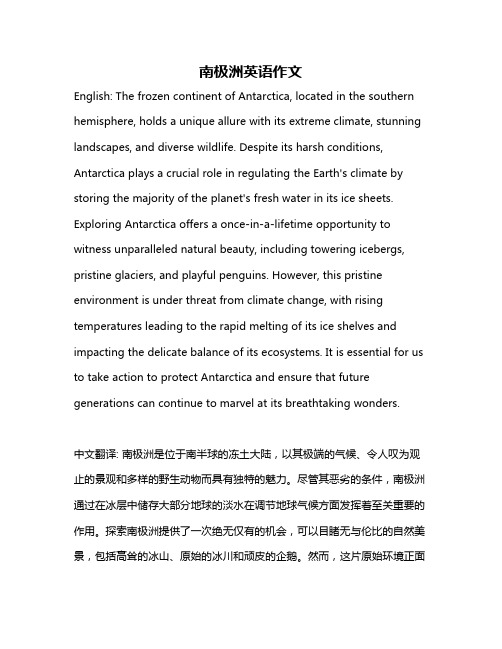
南极洲英语作文English: The frozen continent of Antarctica, located in the southern hemisphere, holds a unique allure with its extreme climate, stunning landscapes, and diverse wildlife. Despite its harsh conditions, Antarctica plays a crucial role in regulating the Earth's climate by storing the majority of the planet's fresh water in its ice sheets. Exploring Antarctica offers a once-in-a-lifetime opportunity to witness unparalleled natural beauty, including towering icebergs, pristine glaciers, and playful penguins. However, this pristine environment is under threat from climate change, with rising temperatures leading to the rapid melting of its ice shelves and impacting the delicate balance of its ecosystems. It is essential for us to take action to protect Antarctica and ensure that future generations can continue to marvel at its breathtaking wonders.中文翻译: 南极洲是位于南半球的冻土大陆,以其极端的气候、令人叹为观止的景观和多样的野生动物而具有独特的魅力。
南极的中英文介绍

南极的中英文介绍中文介绍:南极,这片神秘而广阔的大陆,位于地球的最南端,几乎完全被冰雪覆盖。
它是地球上唯一没有永久居民的大陆,也是人类探索和研究的最晚的处女地之一。
南极的气候极其严酷,全年大部分时间都处于极寒状态,温度可以低至零下60摄氏度。
然而,正是这种极端的气候条件,使得南极成为了一个独特的生态系统,孕育了大量的野生动物,如企鹅、海豹和鲸鱼等。
英文介绍:Antarctica, this mysterious and vast continent, lies at the southernmost tip of the Earth, almost entirely covered in ice and snow. It is the only continent on Earth without permanent human residents and one of the latest to be explored and studied humans. The climate of Antarctica is extremely harsh, with most of the year spent in extreme cold, temperatures can drop to as low as 60 degrees Celsius. However, it is precisely these extreme climatic conditions that make Antarctica a unique ecosystem, nurturing a large number of wildlife, such as penguins, seals, and whales.中文介绍:南极的地质历史可以追溯到数亿年前,当时它曾是连接南美洲、非洲、印度和澳大利亚的古大陆的一部分。
随着时间的推移,这些大陆逐渐分离,南极洲最终形成了今天的模样。
关于南极洲的英语作文小学
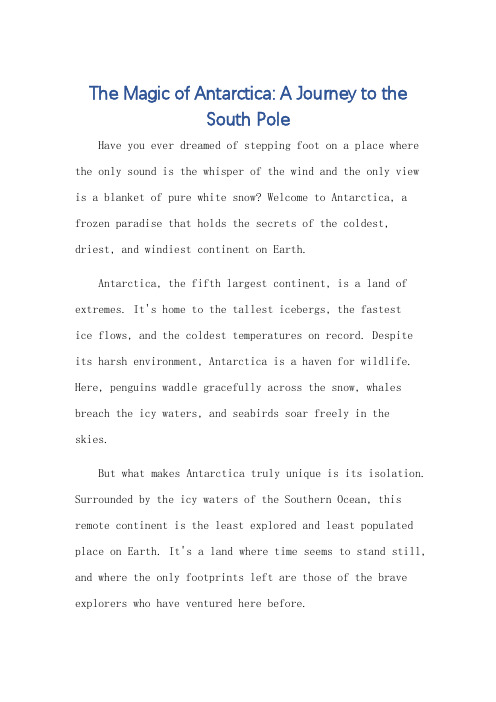
The Magic of Antarctica: A Journey to theSouth PoleHave you ever dreamed of stepping foot on a place where the only sound is the whisper of the wind and the only view is a blanket of pure white snow? Welcome to Antarctica, a frozen paradise that holds the secrets of the coldest, driest, and windiest continent on Earth.Antarctica, the fifth largest continent, is a land of extremes. It's home to the tallest icebergs, the fastestice flows, and the coldest temperatures on record. Despite its harsh environment, Antarctica is a haven for wildlife. Here, penguins waddle gracefully across the snow, whales breach the icy waters, and seabirds soar freely in the skies.But what makes Antarctica truly unique is its isolation. Surrounded by the icy waters of the Southern Ocean, this remote continent is the least explored and least populated place on Earth. It's a land where time seems to stand still, and where the only footprints left are those of the brave explorers who have ventured here before.Visiting Antarctica is a once-in-a-lifetime experience. As you stand on the deck of a research vessel, the vast expanse of white snow and ice stretches out before you, and you feel a sense of awe and humility. You realize that you are just a small part of this vast and mysterious world.But Antarctica is not just about its beauty and isolation. It's also a reminder of our responsibility towards the environment. As the effects of climate change become increasingly evident, Antarctica stands as a sentinel, warning us of the consequences of our actions.It's a call to action, urging us to protect our planet and preserve its natural wonders for future generations.In conclusion, Antarctica is a magical place thatoffers an unparalleled experience. It's a journey into the unknown, a chance to witness the beauty and fragility of our planet. As you stand on the South Pole, surrounded by nothing but ice and snow, you feel a sense of connection to the natural world and a renewed sense of purpose. Antarctica, the land of dreams and adventure, is a must-visit destination for anyone who loves nature and exploration.**南极洲的魔力:通往南极点的旅程**你是否曾梦想过踏上这样一片土地,那里唯一的声音是风的低语,唯一的景色是纯白的雪毯?欢迎来到南极洲,地球上最冷、最干燥、风力最强的大陆的冰雪天堂。
关于南极洲的知识英语作文
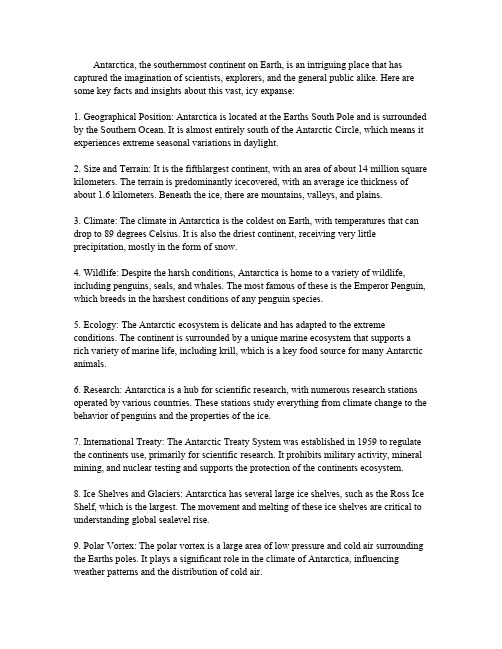
Antarctica,the southernmost continent on Earth,is an intriguing place that has captured the imagination of scientists,explorers,and the general public alike.Here are some key facts and insights about this vast,icy expanse:1.Geographical Position:Antarctica is located at the Earths South Pole and is surrounded by the Southern Ocean.It is almost entirely south of the Antarctic Circle,which means it experiences extreme seasonal variations in daylight.2.Size and Terrain:It is the fifthlargest continent,with an area of about14million square kilometers.The terrain is predominantly icecovered,with an average ice thickness of about1.6kilometers.Beneath the ice,there are mountains,valleys,and plains.3.Climate:The climate in Antarctica is the coldest on Earth,with temperatures that can drop to89degrees Celsius.It is also the driest continent,receiving very little precipitation,mostly in the form of snow.4.Wildlife:Despite the harsh conditions,Antarctica is home to a variety of wildlife, including penguins,seals,and whales.The most famous of these is the Emperor Penguin, which breeds in the harshest conditions of any penguin species.5.Ecology:The Antarctic ecosystem is delicate and has adapted to the extreme conditions.The continent is surrounded by a unique marine ecosystem that supports a rich variety of marine life,including krill,which is a key food source for many Antarctic animals.6.Research:Antarctica is a hub for scientific research,with numerous research stations operated by various countries.These stations study everything from climate change to the behavior of penguins and the properties of the ice.7.International Treaty:The Antarctic Treaty System was established in1959to regulate the continents use,primarily for scientific research.It prohibits military activity,mineral mining,and nuclear testing and supports the protection of the continents ecosystem.8.Ice Shelves and Glaciers:Antarctica has several large ice shelves,such as the Ross Ice Shelf,which is the largest.The movement and melting of these ice shelves are critical to understanding global sealevel rise.9.Polar Vortex:The polar vortex is a large area of low pressure and cold air surrounding the Earths poles.It plays a significant role in the climate of Antarctica,influencing weather patterns and the distribution of cold air.10.Mystery and Exploration:Antarctica remains a place of mystery and exploration. While much is known about its geography and wildlife,there is still much to learn about its geology,climate history,and the potential for life beneath its ice.In conclusion,Antarctica is a continent of extremes,offering a unique environment for scientific study and a stark reminder of the power and resilience of life in the most inhospitable conditions on our planet.。
英语阅读 南极洲
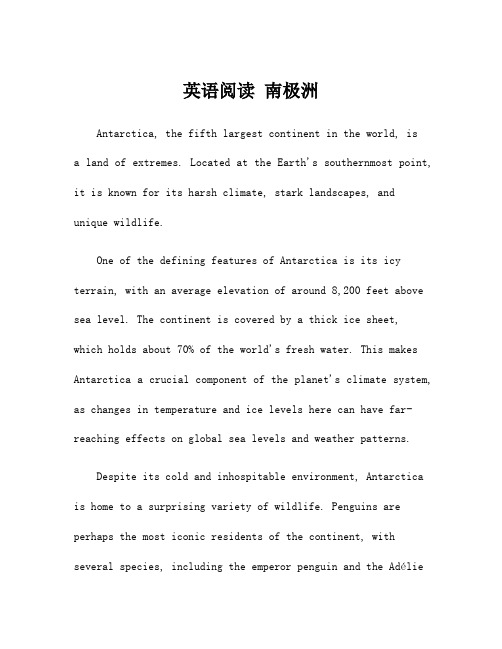
英语阅读南极洲Antarctica, the fifth largest continent in the world, isa land of extremes. Located at the Earth's southernmost point, it is known for its harsh climate, stark landscapes, and unique wildlife.One of the defining features of Antarctica is its icy terrain, with an average elevation of around 8,200 feet above sea level. The continent is covered by a thick ice sheet, which holds about 70% of the world's fresh water. This makes Antarctica a crucial component of the planet's climate system, as changes in temperature and ice levels here can have far-reaching effects on global sea levels and weather patterns.Despite its cold and inhospitable environment, Antarctica is home to a surprising variety of wildlife. Penguins are perhaps the most iconic residents of the continent, with several species, including the emperor penguin and the Adéliepenguin, making their homes here. Other animals that call Antarctica home include seals, whales, and a variety of seabirds.Antarctica is also a hub of scientific research, with numerous research stations operated by countries from around the world. Scientists come to Antarctica to study everything from climate change and glaciology to astronomy and microbiology. The continent's remote location and harsh conditions make it an ideal laboratory for studying some of the most pressing questions facing our planet today.In recent years, Antarctica has been the focus of growing concerns about the impacts of climate change. Rising temperatures have led to a significant increase in melting ice and shrinking glaciers, with potentially catastrophic consequences for global sea levels. Researchers are closely monitoring these changes and working to understand their implications for the future of the planet.Despite its challenges, Antarctica remains a source of wonder and fascination for people around the world. Its pristine landscapes, unique wildlife, and importantscientific discoveries continue to capture the imagination of all who visit or study this remote and awe-inspiring continent.。
南极洲为题英文作文
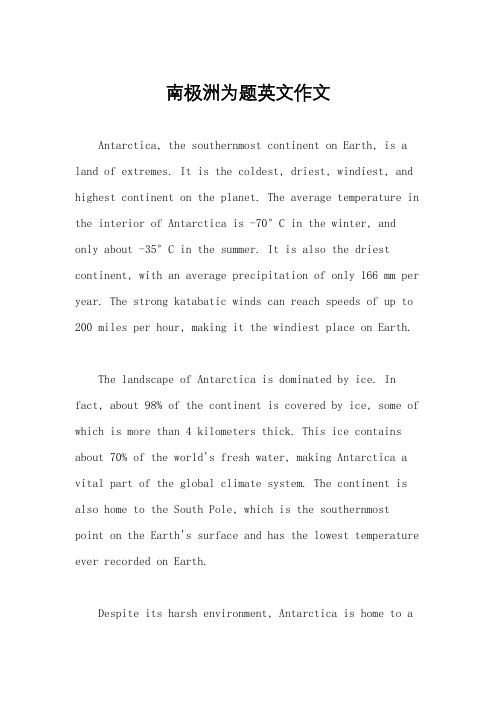
南极洲为题英文作文Antarctica, the southernmost continent on Earth, is a land of extremes. It is the coldest, driest, windiest, and highest continent on the planet. The average temperature in the interior of Antarctica is -70°C in the winter, and only about -35°C in the summer. It is also the driest continent, with an average precipitation of only 166 mm per year. The strong katabatic winds can reach speeds of up to 200 miles per hour, making it the windiest place on Earth.The landscape of Antarctica is dominated by ice. In fact, about 98% of the continent is covered by ice, some of which is more than 4 kilometers thick. This ice contains about 70% of the world's fresh water, making Antarctica a vital part of the global climate system. The continent is also home to the South Pole, which is the southernmost point on the Earth's surface and has the lowest temperature ever recorded on Earth.Despite its harsh environment, Antarctica is home to asurprising variety of wildlife. Penguins, seals, and seabirds thrive in the nutrient-rich waters surrounding the continent, while a few hardy species of plants and insects can be found on the few ice-free areas. The Southern Ocean, which surrounds Antarctica, is one of the most productive marine ecosystems in the world, supporting a rich diversity of marine life.Antarctica is also a place of great scientific interest. Researchers from around the world come to study the unique environment and climate of the continent, as well as its impact on the rest of the planet. Studies of Antarctica'sice cores have provided important insights into pastclimate change, while ongoing research helps us understand the potential effects of future climate change.In addition to its scientific importance, Antarctica is also a place of great natural beauty. The vast, pristine landscapes of ice and snow, the otherworldly colors of the polar sky, and the sight of wildlife thriving in such a harsh environment make Antarctica a truly awe-inspiring place to visit. However, due to its extreme conditions andfragile ecosystems, tourism in Antarctica is strictly regulated to minimize its impact on the environment.。
南极洲作文英文

南极洲作文英文Antarctica is a continent that has captivated the imagination of explorers, scientists, and adventurers for centuries. Located at the southernmost point of the Earth, this vast icy landmass is a place of stark beauty, extreme conditions, and fascinating scientific discoveries. As the coldest, driest, and windiest continent on the planet, Antarctica presents a unique set of challenges and opportunities for those who venture there.One of the most remarkable aspects of Antarctica is its sheer size and isolation. Covering an area of approximately 14.2 million square kilometers, it is the fifth-largest continent on Earth, yet it is also the least populated, with a permanent population of only a few thousand people. The continent is surrounded by the Southern Ocean, which is known for its treacherous seas and powerful currents, making it a formidable barrier to entry.Despite its remote location and inhospitable climate, Antarctica has long been the subject of intense scientific interest. The continent's unique geological and climatic conditions have provided researcherswith a wealth of data and insights into the Earth's past, present, and future. From studying the effects of climate change on the continent's ice sheets to exploring the diverse and often unique ecosystems found in the region, scientists have made numerous groundbreaking discoveries in Antarctica.One of the most significant scientific endeavors in Antarctica is the study of the continent's ice sheets. These massive sheets of ice, which can reach depths of up to 4.8 kilometers, contain a wealth of information about the Earth's past climate. By analyzing ice cores extracted from these sheets, scientists can gain insights into the planet's temperature, precipitation, and atmospheric composition over thousands of years. This information is crucial for understanding the long-term trends and patterns of climate change, and for developing strategies to mitigate its effects.In addition to its scientific importance, Antarctica is also a place of great cultural and historical significance. The continent has been the site of numerous expeditions and explorations, dating back to the early 19th century. From the heroic efforts of explorers like Robert Falcon Scott and Ernest Shackleton to the more recent achievements of modern-day researchers and adventurers, Antarctica has inspired countless stories of human endurance, bravery, and determination.One of the most famous and iconic figures in the history of Antarcticexploration is Sir Ernest Shackleton. In 1914, Shackleton led an expedition to the continent with the goal of being the first to cross Antarctica from coast to coast. However, his ship, the Endurance, became trapped in the ice and was eventually crushed, leaving the crew stranded on the ice floes. Despite the seemingly hopeless situation, Shackleton and his crew managed to survive for over a year, eventually making a daring rescue mission that is now considered one of the greatest feats of human endurance and survival in history.Today, Antarctica continues to be a hub of scientific activity and exploration. Numerous research stations and outposts dot the continent, each focused on a different aspect of the region's unique ecosystem and climate. From studying the effects of climate change on the continent's wildlife to exploring the potential for renewable energy sources, the work being done in Antarctica is crucial for our understanding of the planet and our efforts to protect it.Despite the challenges and hardships associated with living and working in Antarctica, the continent's allure remains strong. For many, the opportunity to experience the vast, untamed wilderness of this remote and mysterious land is a once-in-a-lifetime opportunity. Whether it's the stunning vistas of towering glaciers and pristine snow-covered landscapes or the thrill of encountering the diverse array of wildlife that call Antarctica home, the continent continues to captivate and inspire those who venture there.In conclusion, Antarctica is a truly remarkable and awe-inspiring place. From its scientific importance to its rich cultural and historical significance, the continent has captured the imagination of people around the world. As we continue to grapple with the challenges of climate change and environmental preservation, the work being done in Antarctica will become increasingly crucial. Whether you are a scientist, an explorer, or simply someone who is fascinated by the natural world, Antarctica is a place that is sure to leave a lasting impression.。
关于南极洲的英语作文
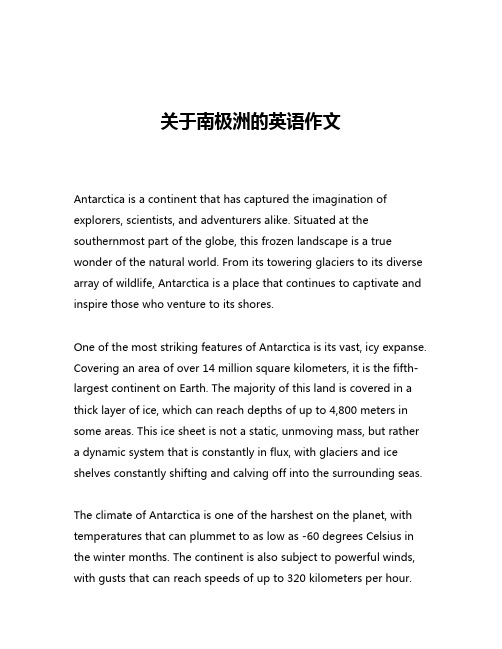
关于南极洲的英语作文Antarctica is a continent that has captured the imagination of explorers, scientists, and adventurers alike. Situated at the southernmost part of the globe, this frozen landscape is a true wonder of the natural world. From its towering glaciers to its diverse array of wildlife, Antarctica is a place that continues to captivate and inspire those who venture to its shores.One of the most striking features of Antarctica is its vast, icy expanse. Covering an area of over 14 million square kilometers, it is the fifth-largest continent on Earth. The majority of this land is covered in a thick layer of ice, which can reach depths of up to 4,800 meters in some areas. This ice sheet is not a static, unmoving mass, but rather a dynamic system that is constantly in flux, with glaciers and ice shelves constantly shifting and calving off into the surrounding seas.The climate of Antarctica is one of the harshest on the planet, with temperatures that can plummet to as low as -60 degrees Celsius in the winter months. The continent is also subject to powerful winds, with gusts that can reach speeds of up to 320 kilometers per hour.Despite these extreme conditions, Antarctica is home to a diverse array of wildlife, including penguins, seals, whales, and a variety of birds and insects.One of the most iconic and well-known inhabitants of Antarctica is the penguin. There are several species of penguins that call the continent home, including the emperor penguin, the Adelie penguin, and the chinstrap penguin. These flightless birds are uniquely adapted to the harsh Antarctic environment, with thick feathers and a layer of insulating fat that helps them to withstand the cold. Penguins are also remarkable for their social behavior, often living in large colonies and engaging in complex courtship rituals.In addition to penguins, Antarctica is home to a variety of other marine life, including seals, whales, and a rich diversity of fish and invertebrates. The waters surrounding the continent are particularly rich in krill, a small shrimp-like crustacean that serves as a vital food source for many of the region's predators. Whales, such as the humpback and killer whale, are also common sights in the waters around Antarctica, drawn by the abundance of krill and other prey.Beyond its natural wonders, Antarctica is also a hub of scientific research and exploration. The continent is home to numerous research stations operated by various countries, where scientists from around the world come to study the unique environment andits inhabitants. From climate research to the study of glaciology and marine biology, Antarctica has become an important center for scientific discovery and innovation.One of the most significant challenges facing Antarctica today is the threat of climate change. As global temperatures continue to rise, the continent's ice sheets and glaciers are under increasing pressure, with some estimates suggesting that the continent could lose as much as 30% of its ice by the end of the century. This has far-reaching implications not only for the continent's wildlife, but also for the global climate system as a whole.Despite these challenges, however, Antarctica remains a place of wonder and possibility. For those who have had the privilege of visiting the continent, the experience is often described as life-changing, a chance to witness the raw power and beauty of the natural world in a way that is simply not possible anywhere else on Earth.Whether it is the stunning vistas of the continent's towering mountains and glaciers, the awe-inspiring sight of a humpback whale breaching the surface of the ocean, or the simple joy of watching a colony of penguins going about their daily lives, Antarctica has a way of captivating and inspiring all who encounter it.As we look to the future, it is clear that the preservation and protection of this remarkable continent will be of paramount importance. Through continued scientific research, international cooperation, and a commitment to sustainable practices, we can work to ensure that Antarctica remains a place of wonder and discovery for generations to come.。
南极洲英语作文
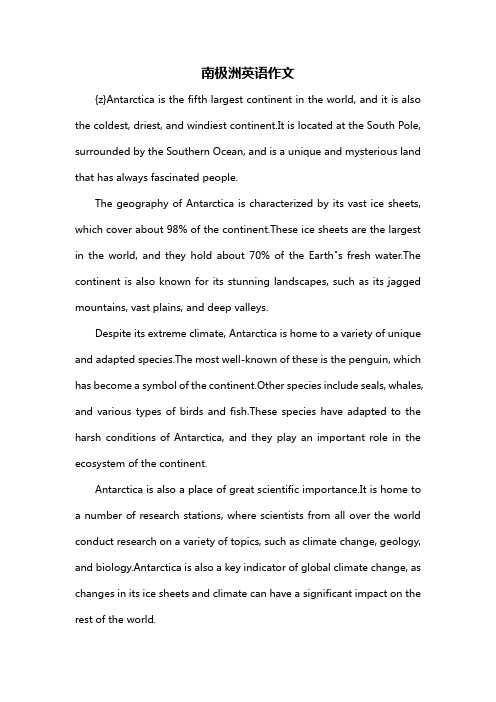
南极洲英语作文{z}Antarctica is the fifth largest continent in the world, and it is also the coldest, driest, and windiest continent.It is located at the South Pole, surrounded by the Southern Ocean, and is a unique and mysterious land that has always fascinated people.The geography of Antarctica is characterized by its vast ice sheets, which cover about 98% of the continent.These ice sheets are the largest in the world, and they hold about 70% of the Earth"s fresh water.The continent is also known for its stunning landscapes, such as its jagged mountains, vast plains, and deep valleys.Despite its extreme climate, Antarctica is home to a variety of unique and adapted species.The most well-known of these is the penguin, which has become a symbol of the continent.Other species include seals, whales, and various types of birds and fish.These species have adapted to the harsh conditions of Antarctica, and they play an important role in the ecosystem of the continent.Antarctica is also a place of great scientific importance.It is home to a number of research stations, where scientists from all over the world conduct research on a variety of topics, such as climate change, geology, and biology.Antarctica is also a key indicator of global climate change, as changes in its ice sheets and climate can have a significant impact on the rest of the world.In addition to its scientific importance, Antarctica also has cultural significance.It has been a source of inspiration for artists, writers, and explorers for centuries.The continent has also been the subject of numerous scientific expeditions, and the stories of these expeditions have become part of the cultural heritage of many countries.Despite its remote location and extreme climate, Antarctica is a place that holds great importance for the world.It is a unique and beautiful land, and it is a key part of our planet"s natural heritage.As we face the challenges of climate change and environmental degradation, it is more important than ever to protect and preserve this unique and special place.。
南极洲英语作文

The Mysterious and Fragile Beauty ofAntarcticaNestled at the bottom of the Earth, Antarctica stands as a frozen paradise, a land of extremes and unmatched beauty. Covering an area larger than Europe and Asia combined, this icy continent is home to a vast array of wildlife, including penguins, whales, and seals, all of which thrive in this harsh yet unique environment.The history of Antarctica is as fascinating as its landscape. Discovered by explorers in the early 19th century, it has been a subject of scientific interest ever since. The continent has been the stage for numerous expeditions and research projects, all aimed at understanding this frozen world and its impact on the global climate.The climate of Antarctica is extreme, with temperatures often dipping below -50°C. The landscape is dominated by vast ice sheets and glaciers, which have carved out a landscape of mountains, valleys, and icebergs. Despite its inhospitable nature, Antarctica is rich in biodiversity,with many species of animals adapting to the harsh conditions.One of the most endearing features of Antarctica is its wildlife. Penguins, with their waddle and adorable antics, are a favorite among visitors. These flightless birdsthrive in the cold, using their dense feathers and body fat to keep warm. Whales and seals are also common sights, with their majestic size and powerful movements adding to the awe-inspiring nature of the continent.The ecological significance of Antarctica cannot be overstated. As a global repository of fresh water and a key player in the Earth's climate system, Antarctica plays a crucial role in maintaining the stability of the planet's environment. Changes in Antarctica's ice sheets can havefar-reaching effects on global sea levels and weather patterns.Unfortunately, Antarctica is also facing threats. Climate change, pollution, and human activity are all taking their toll on this fragile ecosystem. The melting of ice sheets and glaciers is加速, leading to rises in sea levels and changes in ocean currents. This, in turn, canaffect weather patterns and climate systems around the world.The protection of Antarctica is crucial. As a global heritage site and a natural laboratory for climate research, it must be preserved for future generations. International agreements and treaties, such as the Antarctic Treaty, aimto protect the continent from harmful human activities and ensure that its resources are used responsibly.In conclusion, Antarctica is a land of wonders, afrozen paradise that must be cherished and protected. Its beauty, biodiversity, and ecological significance make it a vital part of our planet's ecosystem. As we face the challenges of climate change and environmental degradation, it is important to remember that Antarctica is not just afar-off land of ice and snow; it is a critical component of our shared future.**南极洲:神秘而脆弱的美丽**位于地球底部的南极洲,是一个冰封的天堂,一个充满极端和无与伦比美丽的土地。
关于南极洲的英语作文
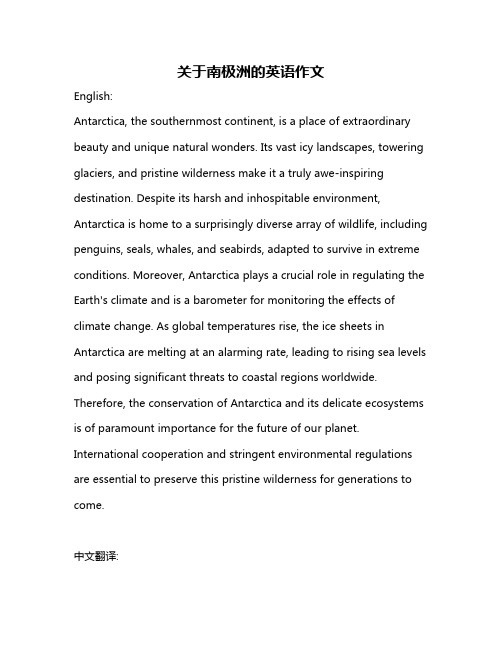
关于南极洲的英语作文English:Antarctica, the southernmost continent, is a place of extraordinary beauty and unique natural wonders. Its vast icy landscapes, towering glaciers, and pristine wilderness make it a truly awe-inspiring destination. Despite its harsh and inhospitable environment, Antarctica is home to a surprisingly diverse array of wildlife, including penguins, seals, whales, and seabirds, adapted to survive in extreme conditions. Moreover, Antarctica plays a crucial role in regulating the Earth's climate and is a barometer for monitoring the effects of climate change. As global temperatures rise, the ice sheets in Antarctica are melting at an alarming rate, leading to rising sea levels and posing significant threats to coastal regions worldwide. Therefore, the conservation of Antarctica and its delicate ecosystems is of paramount importance for the future of our planet. International cooperation and stringent environmental regulations are essential to preserve this pristine wilderness for generations to come.中文翻译:南极洲,地处地球最南端,是一个充满非凡美丽和独特自然奇观的地方。
五年级五年级的关于南极英语作文

五年级五年级的关于南极英语作文The Antarctic is a continent located at the southernmost part of the Earth. 南极洲是地球最南端的一个大陆。
It is covered in ice and is home to various species of wildlife. 它被冰雪覆盖,是许多野生动物的家园。
Exploring the Antarctic can be a thrilling and awe-inspiring adventure. 探索南极洲可能是一次激动人心、令人敬畏的冒险。
The Antarctic is known for its extreme cold temperatures, with the lowest ever recorded being around -89 degrees Celsius. 南极洲以其极端寒冷的温度而闻名,有着历史上记录的最低温度约为零下89摄氏度。
The harsh environment poses challenges for anyone who wishes to visit the continent. 这种恶劣的环境对任何希望访问南极洲的人来说都是一个挑战。
Despite the challenges, many scientists and researchers are drawn to the Antarctic to study its unique ecosystem. 尽管面临诸多挑战,许多科学家和研究者被南极洲独特的生态系统所吸引,前往进行研究。
One of the most iconic animals in the Antarctic is the penguin. 南极洲最具标志性的动物之一就是企鹅。
These adorable creatures can be found waddling on the ice or diving into the freezing waters in search of food. 这些可爱的生物们在冰面上摇摆行走,或者潜入冰冷的海水中寻找食物。
写一篇介绍南极相关知识的作文
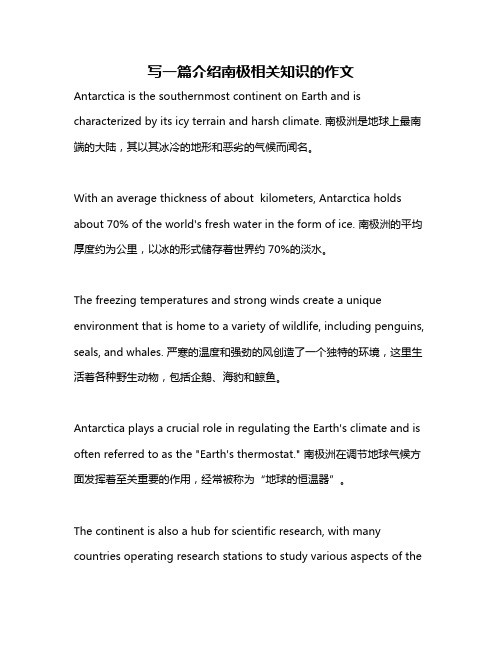
写一篇介绍南极相关知识的作文Antarctica is the southernmost continent on Earth and is characterized by its icy terrain and harsh climate. 南极洲是地球上最南端的大陆,其以其冰冷的地形和恶劣的气候而闻名。
With an average thickness of about kilometers, Antarctica holds about 70% of the world's fresh water in the form of ice. 南极洲的平均厚度约为公里,以冰的形式储存着世界约70%的淡水。
The freezing temperatures and strong winds create a unique environment that is home to a variety of wildlife, including penguins, seals, and whales. 严寒的温度和强劲的风创造了一个独特的环境,这里生活着各种野生动物,包括企鹅、海豹和鲸鱼。
Antarctica plays a crucial role in regulating the Earth's climate and is often referred to as the "Earth's thermostat." 南极洲在调节地球气候方面发挥着至关重要的作用,经常被称为“地球的恒温器”。
The continent is also a hub for scientific research, with many countries operating research stations to study various aspects of theenvironment and climate. 这个大陆也是科学研究的中心,许多国家在此设立研究站,研究环境和气候的各个方面。
南极洲英语作文
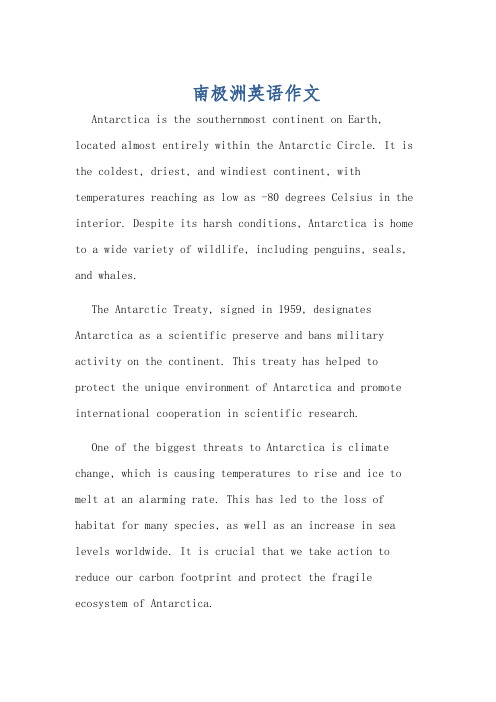
南极洲英语作文Antarctica is the southernmost continent on Earth, located almost entirely within the Antarctic Circle. It is the coldest, driest, and windiest continent, with temperatures reaching as low as -80 degrees Celsius in the interior. Despite its harsh conditions, Antarctica is home to a wide variety of wildlife, including penguins, seals, and whales.The Antarctic Treaty, signed in 1959, designates Antarctica as a scientific preserve and bans military activity on the continent. This treaty has helped to protect the unique environment of Antarctica and promote international cooperation in scientific research.One of the biggest threats to Antarctica is climate change, which is causing temperatures to rise and ice to melt at an alarming rate. This has led to the loss of habitat for many species, as well as an increase in sea levels worldwide. It is crucial that we take action to reduce our carbon footprint and protect the fragile ecosystem of Antarctica.南极洲是地球上最南端的大陆,几乎完全位于南极圈内。
南极洲英语作文100字
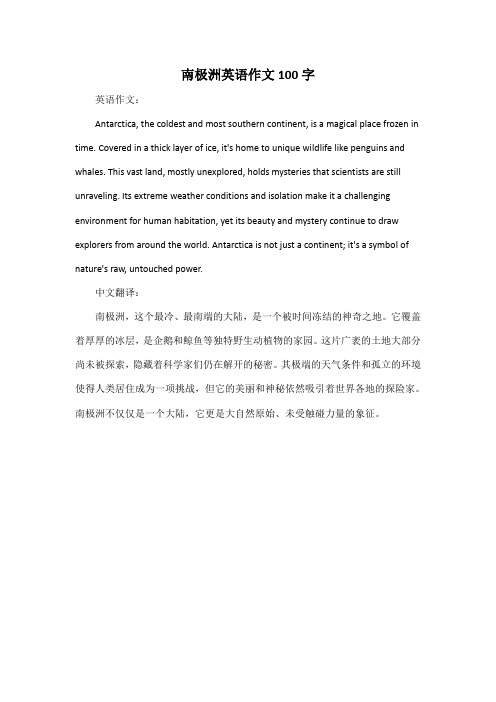
南极洲英语作文100字
英语作文:
Antarctica, the coldest and most southern continent, is a magical place frozen in time. Covered in a thick layer of ice, it's home to unique wildlife like penguins and whales. This vast land, mostly unexplored, holds mysteries that scientists are still unraveling. Its extreme weather conditions and isolation make it a challenging environment for human habitation, yet its beauty and mystery continue to draw explorers from around the world. Antarctica is not just a continent; it's a symbol of nature's raw, untouched power.
中文翻译:
南极洲,这个最冷、最南端的大陆,是一个被时间冻结的神奇之地。
它覆盖着厚厚的冰层,是企鹅和鲸鱼等独特野生动植物的家园。
这片广袤的土地大部分尚未被探索,隐藏着科学家们仍在解开的秘密。
其极端的天气条件和孤立的环境使得人类居住成为一项挑战,但它的美丽和神秘依然吸引着世界各地的探险家。
南极洲不仅仅是一个大陆,它更是大自然原始、未受触碰力量的象征。
南极作文英语简单
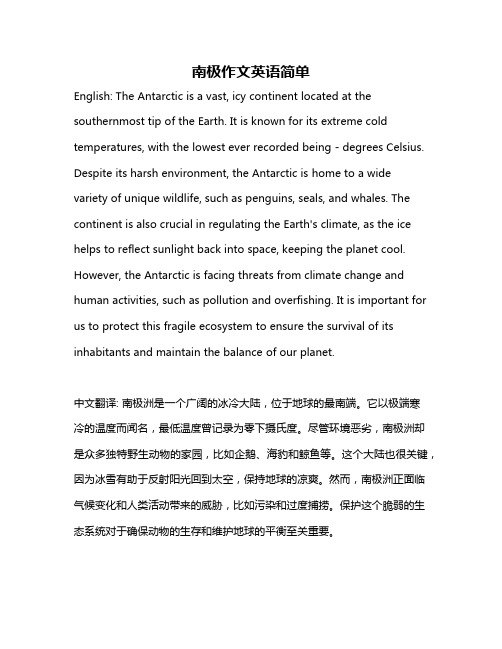
南极作文英语简单English: The Antarctic is a vast, icy continent located at the southernmost tip of the Earth. It is known for its extreme cold temperatures, with the lowest ever recorded being - degrees Celsius. Despite its harsh environment, the Antarctic is home to a wide variety of unique wildlife, such as penguins, seals, and whales. The continent is also crucial in regulating the Earth's climate, as the ice helps to reflect sunlight back into space, keeping the planet cool. However, the Antarctic is facing threats from climate change and human activities, such as pollution and overfishing. It is important for us to protect this fragile ecosystem to ensure the survival of its inhabitants and maintain the balance of our planet.中文翻译: 南极洲是一个广阔的冰冷大陆,位于地球的最南端。
它以极端寒冷的温度而闻名,最低温度曾记录为零下摄氏度。
尽管环境恶劣,南极洲却是众多独特野生动物的家园,比如企鹅、海豹和鲸鱼等。
介绍南极洲的英语作文
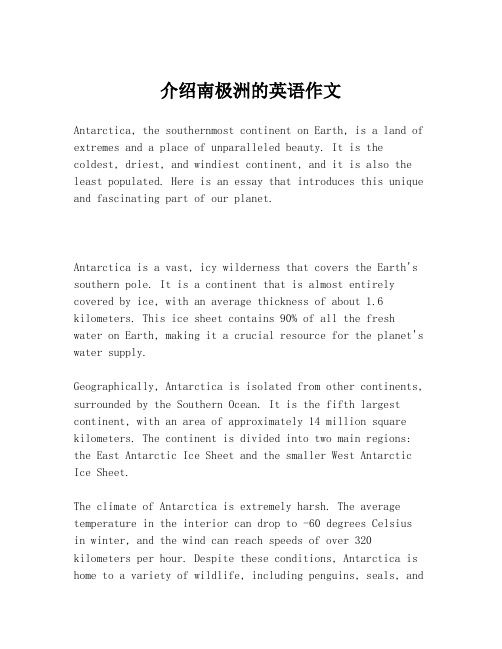
介绍南极洲的英语作文Antarctica, the southernmost continent on Earth, is a land of extremes and a place of unparalleled beauty. It is the coldest, driest, and windiest continent, and it is also the least populated. Here is an essay that introduces this unique and fascinating part of our planet.Antarctica is a vast, icy wilderness that covers the Earth's southern pole. It is a continent that is almost entirely covered by ice, with an average thickness of about 1.6 kilometers. This ice sheet contains 90% of all the fresh water on Earth, making it a crucial resource for the planet's water supply.Geographically, Antarctica is isolated from other continents, surrounded by the Southern Ocean. It is the fifth largest continent, with an area of approximately 14 million square kilometers. The continent is divided into two main regions: the East Antarctic Ice Sheet and the smaller West Antarctic Ice Sheet.The climate of Antarctica is extremely harsh. The average temperature in the interior can drop to -60 degrees Celsius in winter, and the wind can reach speeds of over 320 kilometers per hour. Despite these conditions, Antarctica is home to a variety of wildlife, including penguins, seals, andwhales. These animals have adapted to the extreme environment and are a testament to the resilience of life.Scientifically, Antarctica is a unique place for research. More than 30 countries operate research stations on the continent, conducting studies in fields such as meteorology, glaciology, and marine biology. The continent is alsoprotected by the Antarctic Treaty, which was signed in 1959to ensure that Antarctica is used for peaceful purposes and preserved for scientific research.Tourism is another aspect of Antarctica's modern significance. While tourism is limited and strictly regulated, visitors can experience the breathtaking landscapes, witness the wildlife, and learn about the scientific research being conducted. The Antarctic Peninsula is the most accessible part of the continent and is a popular destination for tourists.In conclusion, Antarctica is a continent of extremes and a place of scientific wonder. Its pristine wilderness, unique wildlife, and valuable scientific contributions make it an essential part of our global community. As we continue to explore and learn from Antarctica, it is our responsibilityto protect and preserve this remarkable place for future generations.。
- 1、下载文档前请自行甄别文档内容的完整性,平台不提供额外的编辑、内容补充、找答案等附加服务。
- 2、"仅部分预览"的文档,不可在线预览部分如存在完整性等问题,可反馈申请退款(可完整预览的文档不适用该条件!)。
- 3、如文档侵犯您的权益,请联系客服反馈,我们会尽快为您处理(人工客服工作时间:9:00-18:30)。
区域范围
由围绕南极的大陆、陆缘冰和岛屿组成、 其中大陆面积1239.3万平方千米、 陆缘冰面积158.2万平方千米、 岛屿面积7.6万平方千米、
地理地貌
• 南极洲是由冈瓦纳大陆分离解体而成,横 贯南极山脉 将南极大陆分成东西两部分。 这两部分在地理和地质上差别很大、
• 东南极洲是一块很古老的大陆,它的中心 位于南极点,从任何海边到南极点的距离 都很远。 东南极洲平均海拔高度2500米, 最大高度4800米、
地形特征
• 地形:横贯南极的山脉将南极大陆分为两部分。东南极洲, 面积较大,为一古老的地盾和准平原,横贯南极山脉绵延 于地盾的边缘;西南极洲面积较小,为一褶皱带,由山地、 高原和盆地组成、
• 南极洲大陆平均海拔2350米,是地球上平均海拔最高的大 洲、
气候特征
• 南极洲的气候是极地气候、特点是酷寒、烈风和 干燥。全洲年平均气温为-25℃,内陆高原平均 气温为-56℃左右、
• 极端最低气温曾达-89.8℃,为世界最冷的陆地。 冬季极端气温很少低于-40℃、
• 世界上最低的气温记录是-88.3℃ 、
自然资源
• 南极洲蕴藏的矿物有220余种。 • 主要有煤、石油、天然气、铂、铀、铁、锰、铜、
镍、钴、铬、铅、锡、锌、金、铜、铝、锑、石 墨、银、金刚石等。 • 主要分布在东南极洲、南极半岛和沿海岛屿地区。
关于生物
• 南极洲腹地几乎是一片不毛之地。那里仅有的生 物就是一些简单的植物和一两种昆虫
• 。气候严寒的南极洲,植物难于生长,偶能见到 一些苔藓、地衣等植物。
• 海岸和岛屿附近有鸟类和海兽。鸟类以企鹅为多。 夏天,企鹅常聚集在沿海一带,构成有代表性的 南极景象。
洋,鲸成群,为世界重要的捕鲸区。
水资源
• 南极洲是个巨大的天然“冷库”,是世界上淡水 的重要储藏地。
• 南极洲径流量少,但冰川都是淡水资源,从淡水 资源的储量看,是个大洲中最多的。
• 多年平均径流量分为一个地区和大洲的总量、人 均的、单位面积的总量、
谢谢、
南极洲
Antarctica
南极洲(英文名称:Antarctica;法文名称:Antarctique
• 中文名称:南极洲 • 外文名称:Antarctica • 别名:第七大陆 • 地理位置:四周濒太平洋、印度洋和大西洋 • 面积:1400万平方千米 • 气候条件:冰原气候、 • 主要动物:企鹅,海豹 • 地形:冰原覆盖的高原 • 西南极洲经度:西经50°-西经160° • 东南极洲经度:西经30°-东经170°
